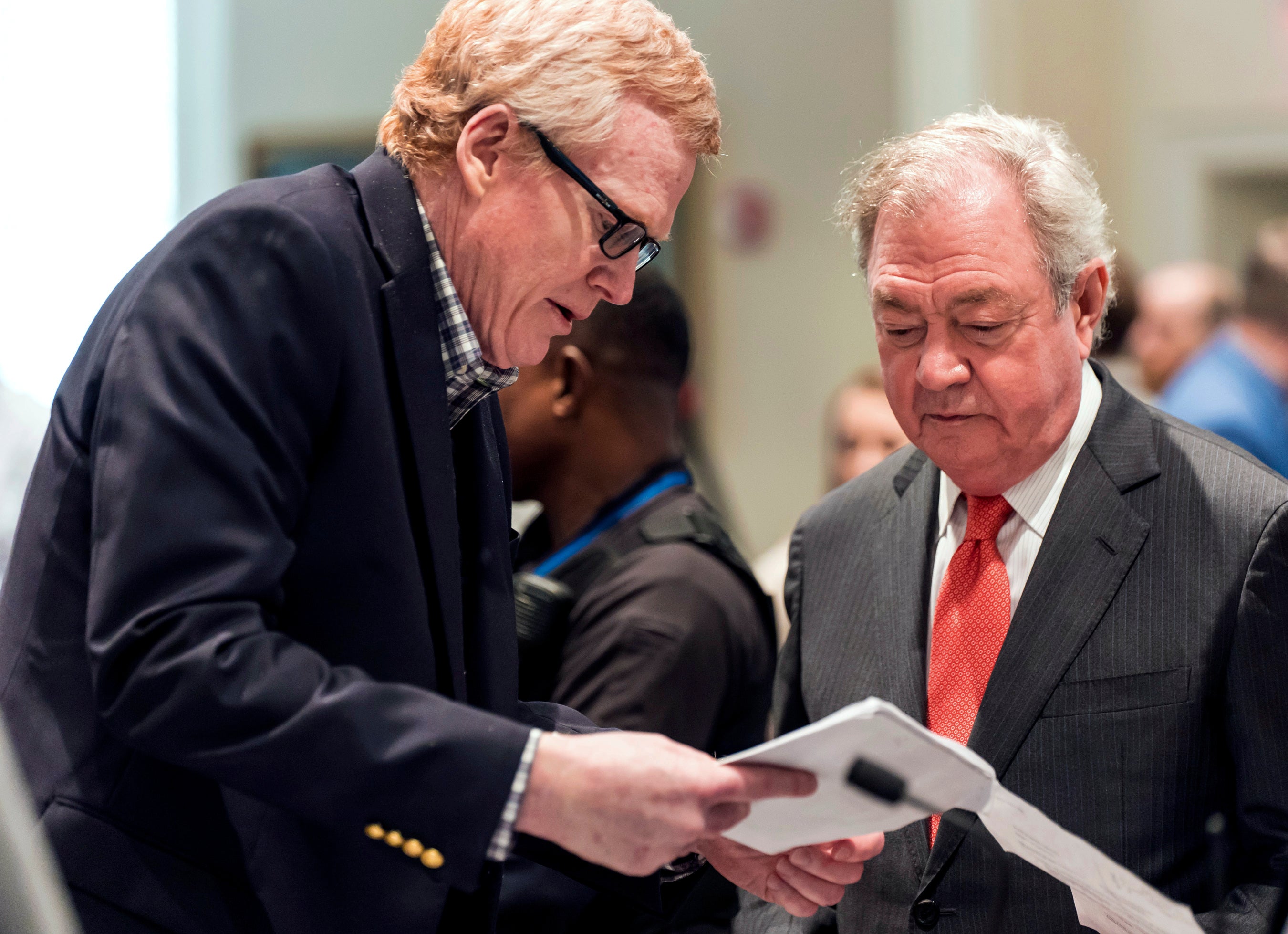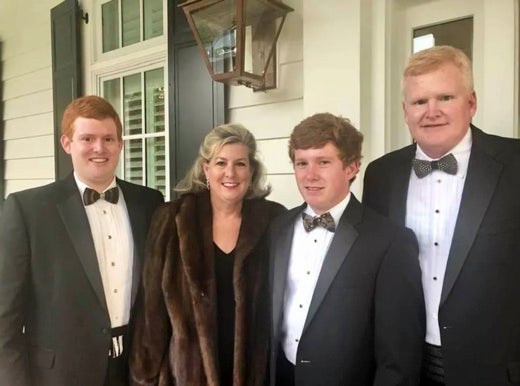
The prosecution has rested its case in Alex Murdaugh’s double murder trial, after calling multiple rebuttal witnesses to the stand to dispute the defence’s expert witnesses and show jurors that the disgraced attorney continued to lie on the witness stand.
The forensic pathologist who carried out the autopsies on Alex Murdaugh’s wife Maggie and son Paul returned to the witness stand in Colleton County Courthouse in Walterboro, South Carolina, on Tuesday where she pushed back against testimony from two defence witnesses who argued that Paul had been shot in the head at point blank range.
Dr Ellen Riemer stood by her conclusions about the victims’ brutal wounds – and told jurors that testimony from two expert witnesses for the defence was “wrong”.
“There is no way that these features are consistent with a contact shotgun wound to the head,” she said.
“The damage to his head wounds would be so much worse.”
If his head wound had been from a contact shotgun blast, Paul’s entire head would have been blown off – with both his entire face and skull exploded by the blast, she said. Instead, she said his face was largely intact and his skull had a large hole in it.
Maggie and Paul were both gunned down at the family’s Moselle hunting estate in Islandton, South Carolina, back on 7 June 2021.
Paul, 22, was shot twice with a 12-gauge shotgun as he stood in the feed room of the kennels, with the second bullet blowing his brain completely from his skull.
Maggie, 52, was shot five times with a .300 Blackout semiautomatic rifle as she tried to flee from her killer.
During the defence’s case – which wrapped up on Monday – two experts gave gruesome testimony arguing that the second – and fatal shot – that killed Paul was a contact wound to the back of the head.
Forensic pathologist Dr Jonathan Eisenstat and crime scene analyst Tim Palmbach both cast doubts on the prosecution’s theory of how the murders unfolded – criticising the state’s prior testimony from Dr Riemer and Dr Kenny Kinsey, an Orangeburg County sheriff’s deputy and crime scene expert.
Both Dr Eisenstat and Mr Palmbach testified that the killer held a shotgun to Paul’s head and pulled the trigger, with the force causing the 22-year-old’s brain to “explode” out of his skull.
Mr Palmbach described the way the shot entered the head and caused “gaseous materials [to] swell and build”. The pressure builds up in the head, creating enough force to push his brain, skull fragments, blood and hair up towards the ceiling and the door of the feed room.

The head wound was the entrance wound which then caused gunshot pellets to travel down through his neck and into his shoulder, he testified.
Because the shot was fired at point blank range, the assailant would have been covered in the victim’s blood and other bodily substances, they said.
This contradicted Dr Riemer’s previous testimony that the fatal shot had entered his shoulder and neck first, then travelled up to his brain – with the head wound being the exit wound.
On Maggie’s wounds, Dr Eisenstat testified that he agreed with Dr Riemer on four of the five gunshot wounds. But on the fifth – the first fatal wound which went through her chest and brain – he had disagreed.
Dr Riemer had testified that the gunshot entered her chest first and travelled up into her brain.
Meanwhile, Dr Eisenstat said the opposite direction took place, with the killer firing a bullet down into Maggie’s head as she leaned forward. The bullet then travelled into her chest, he said.
Based on their conclusions, Mr Palmbach testified that he believed it was more likely two shooters killed Maggie and Paul – a theory the defence has been pushing throughout the trial.
In court on Tuesday, Dr Riemer stood firmly by her conclusions and insisted that Paul’s head wound was an exit wound and that he was not shot at point blank range.
The pathologist, who said that she has carried out around 5,500 autopsies over the years, testified that if Paul had been shot at point blank range the damage would have been “much worse”.
She also found no evidence of soot or stippling on Paul’s head during the autopsy – something that would be consistent with a contact wound.
His wound was “not consistent with a contact shotgun wound to the head,” she said.
The wounds on Paul’s shoulder and neck are also consistent with entry wounds, she said.
She also disputed the defence experts’ testimony on Maggie’s fatal injury saying that the entrance wound in Maggie’s skull could only have come from below.
Dr Riemer also cast doubts on the credibility of the methods used by the defence experts to reach their conclusions, saying they used skin tags to determine the direction of the bullet which is not a reliable method.
Under cross-examination, Mr Harpootlian sought to pick holes in her work, questioning why she didn’t shave Paul’s head to get a closer look at it being an exit wound.
Dr Riemer said that while she could have done that, it is not necessary to in every case. In this case, the totality of evidence showed the head wound was an exit wound and not an entrance wound.
The theory was also torn apart by Dr Kenny Kinsey, an Orangeburg County sheriff’s deputy and crime scene expert, who said it was a “preposterous” theory from the defence.
In a graphic demonstration in the courtroom, Dr Kinsey and South Carolina Attorney General Alan Wilson acted out the defence’s version of how Paul was murdered.
Dr Kinsey then went into gruesome detail about the extent of injuries he has seen on victims who have suffered a contact wound to the head with a shotgun.
Dr Kinsey also rubbished the defence theory of a 5’2” shooter saying there were “too many variables” to determine the angle of the shooting – and therefore the height of the shooter.
During the rebuttal case, the prosecution also sought to show jurors how Mr Murdaugh had continued to lie when he took the stand in his own defence last week – with two of the accused killer’s friends and colleagues, and a law enforcement officer disputing key aspects of his testimony.
Mark Ball, former PMPED law firm partner and Mr Murdaugh’s friend of three decades, also returned to the stand to dispute Mr Murdaugh’s claim that he distrusted law enforcement.
“I never heard Alex say he distrusted law enforcement and believed he had a good relationship with law enforcement,” he said.
Mr Murdaugh had blamed his distrust of SLED for why he had spent the last 20 months lying about his alibi on the night of the murders.
Since the 7 June 2021 murders, the 54-year-old denied ever being at the dog kennels with his wife and son that night, lying to law enforcement, his family and friends about the last time he ever saw them alive.
However, a damning cellphone video taken by Paul at the kennels minutes before the murders captured Paul, Mr Murdaugh and Maggie’s voices at the scene.

Multiple state witnesses – and Mr Ball who appeared to help the state’s case more than the defence during his prior testimony – identified Mr Murdaugh’s voice in the footage.
In a dramatic two days in court last week, Mr Murdaugh took the witness stand and confessed to lying, claiming that he was “paranoid” in part because of a distrust of SLED and because he was encouraged by his lawyer friends not to speak without an attorney present.
But, during a dramatic cross-examination, prosecutor Creighton Waters appeared to catch Mr Murdaugh in another lie as he revealed that Mr Murdaugh had lied from the moment that the first officer arrived on the scene.
Mr Ball confirmed on Tuesday that Mr Murdaugh’s testimony marked the first time he heard him admit to being at the kennels that night.
The longtime friend and colleague was among the group who rushed to Moselle on the night of the murders to be with his friend.
As well as telling him that he had never been to the kennels, Mr Ball also disputed Mr Murdaugh’s testimony about when he touched Maggie’s and Paul’s bodies.
“My recollection of it is that he told me that he went to Maggie and then he went to Paul and rolled Paul over,” he said.
“... The second time it was reversed. He went to Paul, he went to Maggie. I don’t know if it was a slip… but it was before he called 911.”
During his testimony last week, Mr Murdaugh claimed he touched the bodies while on the phone to 911 – testimony that came after data revealed that less than 20 seconds passed between the moment Mr Murdaugh’s car pulled up at the crime scene and the start of his 911 call.
During the 911 call he told the dispatcher he had “already” touched both his wife and son’s bodies to check for signs of life.
Mr Ball’s testimony was echoed by Ronnie Crosby, Mr Murdaugh’s friend of 25 years and his law firm partner at PMPED who also went to Moselle on the night of the murders.
He also testified that it was “clear” to him that the accused killer said he touched the bodies prior to calling 911.
“My understanding was that he checked them before calling 911. That was clear to me,” he said.
He also said that hearing his former friend’s testimony marked the first time he had heard him confess to being there.
Mr Crosby also told the court how Mr Murdaugh stole $75,000 in insurance money from their close friend Barrett Boulware, when he was dying from cancer.
Tensions erupted during Mr Crosby’s testimony whenMr Murdaugh’s defence attorney Dick Harpootlian began shouting at the witness in the courtroom.
During a heated cross-examination, Mr Harpootlian suggested that Mr Crosby was testifying against Mr Murdaugh because he is angry with him about the money he stole from PMPED.
“If you’re implying that I would come in here and somehow shade truth in any way because of that, I would take high offence with that, Mr Harpootlian,” said Mr Crosby.
This prompted Mr Harpootlian to launch into shouting at the state’s witness and scoffing at the notion that he does not feel anger towards Mr Murdaugh over his theft of
“I’m not concerned about your high offence. Are you angry at him for stealing your money?” Mr Harpootlian shouted.
Mr Harpootlian largely continued his combative strategy with the witnesses throughout the day’s proceedings.
Former Hampton County Sheriff T. C. Smalls, the only rebuttal witness who had never before taken the stand, contradicted Mr Murdaugh’s testimony that he had been given permission by law enforcement to fit blue lights in his vehicle – even though he was never a member of law enforcement.
Mr Smalls, who retired in December after 39 years in law enforcement and has known Mr Murdaugh for many years, testified that he didn’t know anything about the blue lights on Mr Murdaugh’s vehicle and “hever had a conversation with anyone in my 39 years about anyone doing that”.
“I never had any knowledge that he had blue lights in the vehicle,” he said.
During Mr Murdaugh’s testifimony in his own defence last week, he admitted to jurors that he had fitted blue police lights in his vehicle. He had claimed that he had asked the sheriff about having the lights fitted and was given permission – a claim the sheriff has now denied.
Jurors also heard new testimony from Paul McManigal, the Charleston County digital forensics examiner who previously tetsified to trying and failing to unlock Paul’s cellphone after the murders.
He told the court how he carried out some experiments on a cellphone similar to Maggie’s and found that if the phone was “thrown like a frisbee” the screen would not come on.
“When the phone is thrown more like a frisbee 9 out of 10 times it does not turn on,” he said.
If the phone is picked up gently and rotated the screen comes on whereas if the phone is picked up aggressively it does not.
Maggie’s phone was found dumped along Moselle Road the day after the murders with prosecutors claiming that Mr Murdaugh tossed it there as he sped to his parents’ home minutes after killing her and Paul.
Yet, Mr McManigal’s testimony was marred by the defence undermining the nature of the experiment – after he admitted he took no notes, didn’t record what he was doing, and sat in his office on his own “playing with the phone” over the weekend.
The defence asked him to be struck as an expert, which the judge denied.
Prosecutors began calling more witnesses to the stand in Colleton County Courthouse on Tuesday morning, as part of its rebuttal case.
Jurors will be taken on a field trip to the Moselle property to see the crime scene where the brutal murders took place for themselves.
At the property, jurors will tour the dog kennels and feed room on the estate where Maggie and Paul were shot dead back on 7 June 2021.
After that, closing arguments will get under way before the jury begins deliberations in the case.
It is possible that, by the end of the week, the disgraced attorney and accused killer will know his fate.
The defence rested its case on Monday after calling 14 witnesses – including Mr Murdaugh’s surviving son Buster and brother John Marvim – over the course of one week as the legal team seeks to try to convince jurors of Mr Murdaugh’s innocence.
The defence’s case has also sought to pick holes in the prosecution’s case and cast doubts on the validity of the investigation, while pushing a theory that two shooters may have carried out the attack.
The defence case came after jurors heard four weeks of dramatic testimony from the prosecution, covering a trove of circumstantial evidence, including cellphone and car data and numerous apparent holes in his alibi for the time for the murders.
Prosecutors claim Mr Murdaugh killed his wife and son to distract from his string of alleged financial crimes – at a time when his multi-million-dollar fraud scheme was on the brink of being exposed.
Mr Murdaugh is facing life in prison for the murders of Maggie and Paul and has pleaded not guilty.
Beyond the murders, the brutal double murders brought to light a series of scandals surrounding Mr Murdaugh including unexplained deaths, a multi-million-dollar fraud scheme and a botched hitman plot.
!["[T]he First and Fifth Amendments Require ICE to Provide Information About the Whereabouts of a Detained Person"](https://images.inkl.com/s3/publisher/cover/212/reason-cover.png?w=600)






